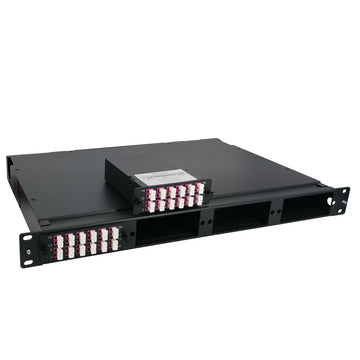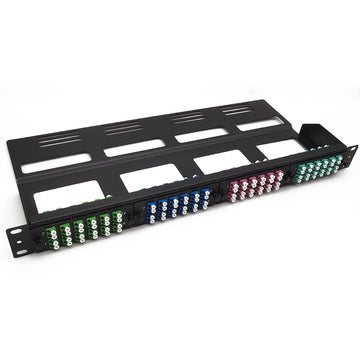What Does SFP Mean And How to Use It?
What does SFP stand for and how to use it? Nowadays, the SFP module is still used as an industry standard by manufacturers and suppliers worldwide. With the increasing demand for higher bandwidth, multiple types of transceiver modules are designed for data transmission, including GBIC, SFP, SFP+, QSFP and so on.
Well, what do SFP stand for? Among them, SFP has been used in popularity for over 15 years. This article will give an answer about “what does SFP mean?” and tell you how to use it.

What Does SFP Mean?
SFP stands for Small Form Factor Pluggable and is also known as a mini-gbic (gigabit interface converter). It is a compact, hot-swappable optical transceiver module that used in telecommunications and data communications networks.
Instead of being standardized by official standards, SFP is specified by the multi-source agreement (MSA). What is MSA? MSA is an agreement between many different transceiver manufactures to make standardized products. So the SFP is compatible across a range of telecoms vendors’ hardware.
And SFP module is designed to support synchronous optical networking (SONET), Gigabit Ethernet, fiber channel and other communication standards. By choosing the appropriate SFP module, the same electrical port on the switch can connect to fibers of different wavelengths and types (multimode or singlemode). If the fiber is upgraded, the SFP module is replaced.
In addition, SFP modules have replaced GBIC modules in most applications due to their small size, allowing them to be used in tight network spaces to provide fast communication between switches and critical network components. SFP module can be categorized into various types under Gigabit Ethernet standards and industry-accepted standards, including 1000BASE-EX, 1000BASE-ZX, 1000BASE-SR and so on.
How to Use SFP Ports on Switch?
The SFP port on the network switch is designed for use with small form factor (SFF) connectors, and offers high speed and physical compactness. The SFP port enables a Gigabit switch to allow optical or copper links by inserting the corresponding SFP module (fiber SFP or copper SFP). And it is most commonly used for the uplink over either short and long transmission distances.
There are several kinds of basic solutions:
Fiber SFP: When SFP ports on switches are inserted into fiber SFP module with optical port, fiber optic cables (SMF fiber / MMF fiber) with duplex LC connector are needed to support the connection.
BiDi SFP: Unlike traditional optical transceivers, BiDi SFP module is fitted with wavelength division multiplexing (WDM) diplexers. It combines and separates data transmitted over a single fiber based on the wavelengths of the light. So It has only one port to transmit and receive optical information on separate wavelength and supports a transmission distance up to 120km.
SFP DAC/AOC: DAC consists of twinax copper cable with SFP DAC connectors on either end. AOC is defined as an fiber jumper cable terminated with SFP AOC connectors on either end. So the SFP DAC/AOC on the DAC/AOC cable can be inserted directly into the corresponding SFP ports on switch.
1000BASE-T Copper SFP: When the SFP ports are plugged by 1000BASE-T copper SFP with electrical port, the network cables such as Cat5e must be used for 1Gbit/s data transmission. What’s more, it is ideal for short reach distance less than 100m.
SFP Port vs. RJ45 Port
SFP or RJ45 Which Should Be Used to Connect Two Switches? It is always a question to choose an access switch with SFP ports or RJ45 Ethernet ports for 1000Mbps connections. RJ45 port vs SFP port, many people wonder the main differences between them. Is RJ45 port or SFP port that suits better for your network? The following table lists the RJ45 connection and SFP connection of Gigabit switches: Learn more about SFP vs RJ45: When to Choose Which?
| Parameter | SFP Port | RJ45 Port |
| Connection Types | RJ45 SFP module + network cable (Cat5e, Cat6 or higher) | network cable (Cat5e, Cat6 or higher) |
| fiber SFP module + fiber optic cable (SMF fiber/MMF fiber) | ||
| Max Distance | MMF (550m)/SMF (150km)/Cat5 (100m) | 100m (330ft) |
| Data Rate | 1000Mbps (1G) | 1000Mbps (1G) |
Learn more about SFP vs RJ45: When to Choose Which?
Conclusion
After reading this article, have you got the answer for “What does SFP mean” ? SFP module is a flexible and necessary device in fiber optical connections. SFP port enables Gigabit switches to connect to a wide variety of fiber and Ethernet cables to extend switching functionality throughout the network. When you choose SFP modules in the market, you’d better consider the corresponding switches and cables for the applications.
LightOptics offers a broad range of copper and fiber SFP modules that are fully compatible with major vendors on the market, which makes us the vendor of choice for optical network components and solutions. If you have any needs, welcome to visit LightOptics.co.uk












